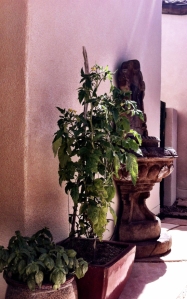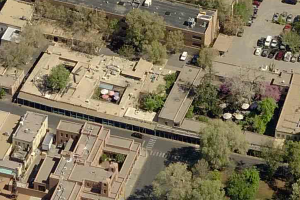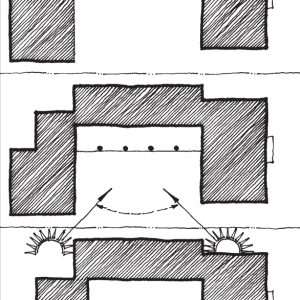A Placemaking Journal
Get Your Garden Room Right
 It’s that time of year here in central New Mexico when I start eating lunch in my courtyard so I can watch the tomatoes turn red. I’m reminded while sitting here of a visit from Steve Mouzon of the Original Green who was lecturing at the University of New Mexico.
It’s that time of year here in central New Mexico when I start eating lunch in my courtyard so I can watch the tomatoes turn red. I’m reminded while sitting here of a visit from Steve Mouzon of the Original Green who was lecturing at the University of New Mexico.
 I live in a zero lot line house with two private courtyards that we enjoy immensely in this high desert climate. Although Steve appreciated the courtyards, his critique of the sideyard and front porch area was that the spaces bleed together and don’t provide the same positive outdoor space of the courtyards. Because they function so well as rooms, we inhabit the courtyards as much as possible.
I live in a zero lot line house with two private courtyards that we enjoy immensely in this high desert climate. Although Steve appreciated the courtyards, his critique of the sideyard and front porch area was that the spaces bleed together and don’t provide the same positive outdoor space of the courtyards. Because they function so well as rooms, we inhabit the courtyards as much as possible.
The suburban notion of the large backyard often provides reduced privacy because of the lack of enclosure. Although kids use them for recreation, they don’t give us the comfort of the outdoor room. With the backyard, you sow grass or lay sod, plant some trees, lay out the perimeter beds, and you’re done. But the lack of spatial definition and privacy relegate them to ball games and maintenance.
 In more urban conditions, privacy becomes crucial to creating useable outdoor space, and buildings become a key to the solution. This is true for commercial spaces as well as residential, and the retail courtyards along East Palace Avenue off the Santa Fe Plaza are a wonderful example. The discussion here also applies to smaller civic spaces within the public domain, as most of the criteria needed for garden rooms apply at that scale as well.
In more urban conditions, privacy becomes crucial to creating useable outdoor space, and buildings become a key to the solution. This is true for commercial spaces as well as residential, and the retail courtyards along East Palace Avenue off the Santa Fe Plaza are a wonderful example. The discussion here also applies to smaller civic spaces within the public domain, as most of the criteria needed for garden rooms apply at that scale as well.
What matters:
- Proportion is key. Use proportions of 1:1, 2:1, 3:2, 4:3, the Golden Mean, or the square root of 2. This may seem constrained, but its rational proportion greatly affects the enjoyment of the space.
- Shape matters. A garden room should be intentional, not just leftover space. Rectangular or square spaces are easiest to furnish and use, although circular or elliptical spaces can be magical.
- Orientation is critical and, depending on climate and region, should be south or some degree off south. Here in New Mexico, we enjoy our southeast orientation since we need protection from the afternoon heat in the summer. Anything within about 45° of due south will usually work.
- Keep it simple. If the space is heavily programmed, it loses flexibility and isn’t as useable on a daily basis. This is a critical point for public plazas as well. A very simple paved surface with seating and shade is the most effective. A fountain or tree works for a garden room, but practice restraint.
- Balance sun and shade. Both are necessary in a habitable space, and make for an all season room. Proper orientation will assure sun in the winter, and shade may be provided by trees, umbrellas or awnings. Umbrellas are the most flexible in small spaces as they can be removed when sun is desired.
If PlaceShakers is our soapbox, our Facebook page is where we step down, grab a drink and enjoy a little conversation. Looking for a heads-up on the latest community-building news and perspective from around the web? Click through and “Like” us and we’ll keep you in the loop.




